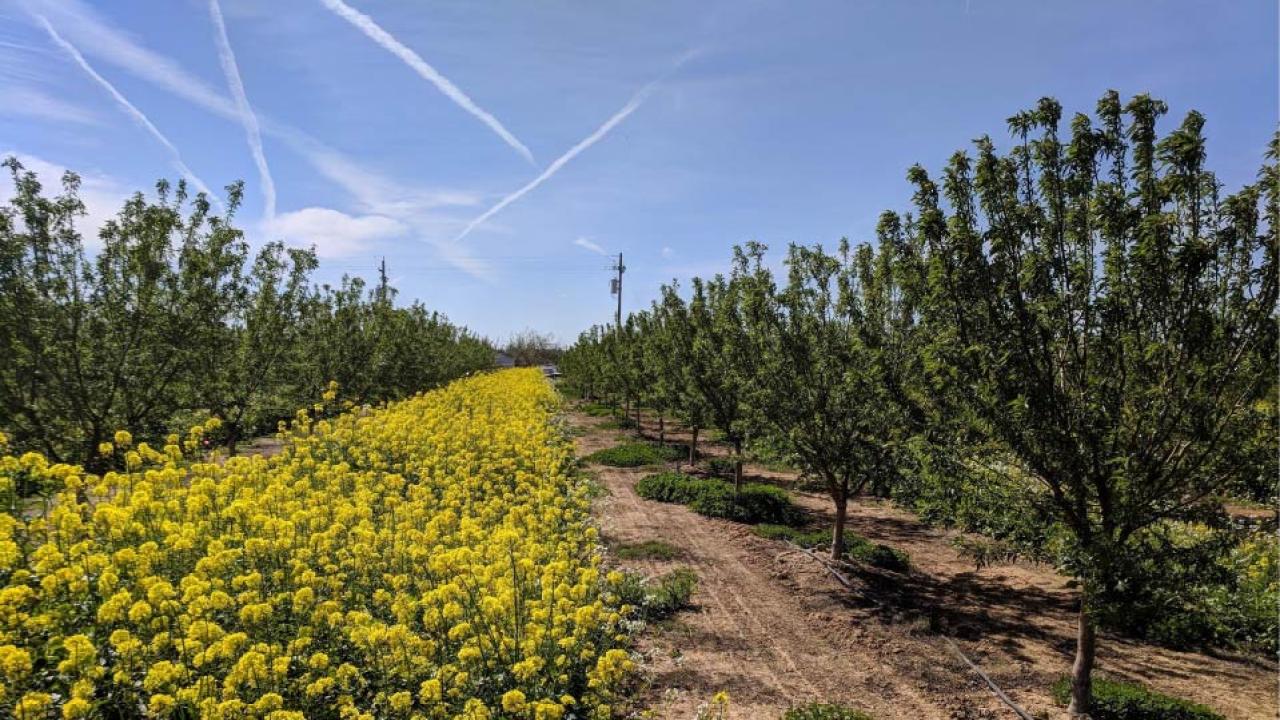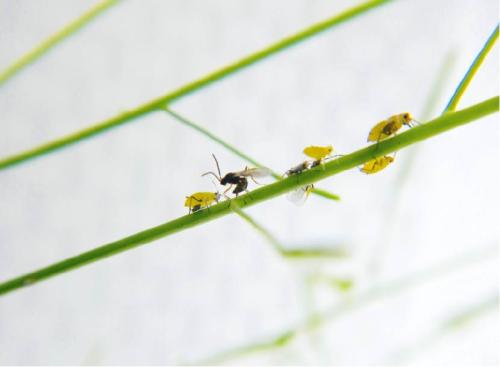
Mustard blooms in an orchard at a UC Davis research site near Corning, Calif. Farmers use mustard extensively as a cover crop. A new experiment shows genetic diversity of mustard could make the agricultural ecosystem richer and more resilient amid rising temperatures.
Diversity matters at the genetic level: A single mutation on a ‘keystone’ gene holds a food web together
Experiment signals 'abrupt and catastrophic shifts' are possible when diversity is lacking
For the first time, an ecologist has shown that genetic variety within one species can affect the survival of other creatures in a larger food web. The discovery has profound implications for crop production and environmental restoration, researchers say.
“It shows that variation within a species could change the whole ecosystem,” said Professor Daniel Kliebenstein in the UC Davis Department of Plant Sciences, a population geneticist who co-supervised the project. “If this extrapolates to other ecosystems, and the lab tests say it should, then everything becomes much more intricately connected in ways we’ve largely not investigated.”

The experiment involved a four-member food web designed by Matthew Barbour, a post-doctoral researcher at the University of Zurich, Switzerland. He found that genetic diversity in just one member of the food web kept the whole web going longer. When genetic variety was lacking, however, the web collapsed faster. That collapse sped up when Barbour raised the temperature, mimicking the predicted effects of global warming.
Barbour’s findings wave new red flags for the growing extinction of plants, insects and animals due to human causes including habitat destruction and climate change. “Our study suggests that the current loss of genetic diversity may have cascading effects that cause abrupt and catastrophic shifts in food-web structure and function,” Barbour wrote in the journal Science, which recently published his study.
Barbour and Kliebenstein collaborated in the experiment with Professor Jordi Bascompte, of the Department of Evolutionary Biology and Environmental Studies at the University of Zurich. A related discussion of their results was first released as a preprint in BioRxiv.
Diversity reduced food web collapse
For five decades, we’ve known that keystone species keep the web of related creatures in balance: If you hunt all the wolves in a forest, the deer population explodes, they devour the plants, then the deer starve. Sea otters keep kelp forests healthy by eating sea urchins. Beavers' dams create nurseries for trout. Wolves, sea otters and beavers are examples of keystone species: Their presence keeps the food web in balance.
Like the keystone of an ancient arch, take out that one, central stone, and the arch collapses.

Barbour, an ecologist, wanted to test the idea of a keystone gene, and whether genetic variety within a single species could affect the survival of other creatures in the web. He built his simple ecosystem on a plant widely used in genetic research, Arabidopsis thaliana, a type of cress related to broccoli, cabbage and mustard. He picked 11 genetic variations of the cress and planted cages with different combinations; some he planted with more genetic diversity, others with less.
Barbour completed the food web by adding two types of aphids, which feed on the cress, and a wasp that preys on the aphids.
In all of the experimental plantings, at least one of the aphid species went extinct by the end of the 17-week study. However, of the simpler, three-member food webs that remained (cress, wasp and one type of aphid), webs with genetically diverse cress were more likely to continue intact. Webs with less-diverse cress collapsed, Barbour reported.
Moreover, Barbour found that one variation of a gene named AOP2, which controls both the plant’s flavor and its related defenses against bugs, made all the difference. “This natural mutation at AOP2 not only affected the plant’s chemistry, but also made the plant grow faster, which in turn helped the herbivores (the aphids) and predators (the wasps) coexist, thereby preventing the ecosystem from collapsing,” Barbour said.
Genetic diversity helped resist warmer temperature
Barbour added another factor to his experiment: He turned up the heat, duplicating what is expected in coming decades if people do nothing to reduce the emissions that cause climate change. The aphids that went extinct first in the other experimental planters died out much faster when temperatures rose, Barbour said.
And again, in the simpler food webs that remained, those with genetically diverse cress lasted longer than webs with less diversity, Barbour found.
Variety in mustard could help farmers
Cress is in the same family as mustard, which shares its cousin's AOP2 gene. Mustard is used extensively in agriculture as a cover crop to reduce weeds and disease, improve soil, attract beneficial bugs that pollinate blossoms and eat pests, and lessen the need for chemical pesticides and fertilizers.
Barbour's experiment offers farmers practical insights into improving their cover crops. “This research says there might be a benefit to asking what genetic varieties of the cover crop to plant, and how that might shape the beneficial insect ecosystem,” Kliebenstein said. Genetically diverse mustard could potentially attract helpful birds and animals, too, making the overall crop ecosystem more sustainable, even as it produces food.
Two disciplines came together
The work also is exceptional for bringing together two usually separate fields of study. Ecology looks at how species interact in an ecosystem, while population genetics looks at variations within a single species, Kliebenstein explained. This collaboration offers exciting possibilities for making agricultural ecosystems more resilient in the face of climate change.
“Our work highlights the potential promise of integrating tools from genetics and ecological networks to predict the consequences of genetic change for the persistence of biodiversity across scales,” Barbour wrote in Science.
